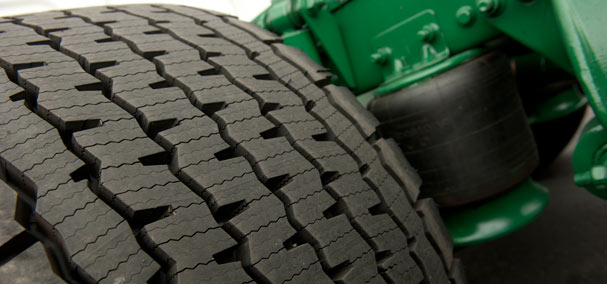Tires are expensive and when you have a lot of them on your rig, the price adds up quickly. Not to mention that the thousands of miles you drive each month causes wear and tear on this essential component of your truck. Wide-base single tires have been around for over a decade now and have become quite popular amongst bulk fleets.
Wide-base single tires certainly have their advantages like less weight and greater fuel savings. However, one issue that has been lingering for some time is the irregular wear pattern of wide-base single tires. Some drivers refuse to try wide-base tires due to these perception. While tire manufacturers will admit that earlier models of wide-base single tires had a higher prevalence rate of irregular wear, newer generations don’t have that issue, especially if you maintain them correctly.

For the last four years Michelin has been trying to develop a solution to the irregular wear patterns. In 2014 they released two new wide-base tires, one designed for the highway, and the second designed for regional use. Both tires were designed with improved tread patterns and casing to better manage load stresses on the tire that will reduce irregular wear on trailer tires. It is common to find trailer tires with more irregular wear than drive tires because of their free-rolling nature. Thankfully with proper proactive maintenance, wide-base single tires can have long lifespans.
Also Read: Tire Rolling Resistance
How to Prevent Irregular Wear in Wide-Base Single Tires
The battle against irregular wear in wide-base single tires is similar to that of dual tires. Factors that affect wide-base tires include poor maintenance, over- or under-inflation, heavy or light loads, and the type of pavement on the roads. Let’s break down these factors and look at how you can prevent irregular wear.
- Inflation and load – It’s the air inside of a tire that supports the weight of the truck, not the tire itself. Wide-base tires tend to be more sensitive to inflation deviations than dual tires. It is recommended that you inflate your tires to the maximum pressure for heavy loads and then deflate them slightly for light or empty loads. For example, Bridgestone recommends that you inflate your tires to 100 psi for 8,820 pounds of tire load on a 445/50R22.5. If you’re running a light or empty load, it’s probably okay to inflate your tires to 85 or 90 psi. While you might find it impossible to inflate and deflate tires constantly, you can consider an inflation/deflation system or lift axles to reduce tire wear. These systems are commonly found in fleet trucks who tend to run a heavy load one way and return with an empty truck.
- Alignment – Alignment is probably the number one killer of tires. Keeping trucks in correct alignment is an expensive maintenance plan, but if you think of it as more of an investment plan, you’ll save money in the long run. Tires will last longer. Not only do trucks need a traditional frontend alignment, but drive axles should be aligned as well.
- Preventive maintenance – Maintaining your rig proactively will not only keep your truck in good health, but help reduce irregular wear on your wide-base tires. Make sure you inspect your truck for worn and loose components, like bushings, shock absorbers, and wheel bearings, which can cause harm to your truck and tires. Loose wheel bearings can cause a negative camber condition that can impact the inside shoulder of the tire.
- Spec’ing – Spec’ing really should be number one because if you don’t put the right tires on your truck, it’s not going to work well. Large fleets with maintenance managers who have a good relationship with their tire dealer are probably doing things right. As owner-operators you probably don’t have this luxury. Don’t be afraid to look around or ask other drivers what kind of tires they run on their trucks. Another method is to look at your scrap tires when they get replaced. Tires tell a story. You can get a good idea if you’re running over- or under-inflated tires or if you’re having alignment issues based on how your tires wear.
Also Read: Prolonging Tire Life
Wide-base single tires could save you more weight and money in the long run. However, the tires tend to have irregular wear patterns that could cost you more money in the end if you’re not proactive about maintaining them. Using the above tips should help you keep those wide-base tires running longer on your truck.